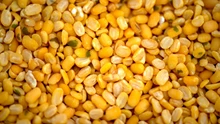
Isabgol is a medicinal rabi crop that is mainly grown in Rajasthan, Gujrat, and Madhya Pradesh. Isabgol, also known as psyllium, is used as a dietary fibre that helps relieve the symptoms of both constipation and mild diarrhoea. Regular consumption of Isabgol lowers the risk of cardiovascular diseases, relieves acidity, helps in weight loss, lowers blood cholesterol, and even cures piles and fissures.
Plant Name- Isabgol
Scientific Name- Plantago ovata Fork
Family- Plantaginaceae
Hindi Name- Isabgol and Isabgul
The word isabgol was derived from the Persian words “isap” and “ghol” which roughly translates to horse ears and is meant to describe the shape of the seeds. The plant can grow somewhere between 30 to 40 cm in height and its seeds are enclosed in capsules that open at maturity.
Location
-
Isabgol is a popular crop that is cultivated across many different parts of the world.
-
As discussed before, the isabgol crop is native to West Asia and the Mediterranean region. In India, isabgol was introduced in North Gujrat and is subsequently cultivated in Rajasthan, Madhya Pradesh, Haryana, Karnataka, Punjab, and Uttar Pradesh.
Season
-
Isabgol is a rabi crop that requires dry heat during its maturity season.
-
Isabgol requires a cool and dry climate to grow. Therefore, it is sown in mid-November when the chances of unseasonal rain are low. Even the littlest bit of moisture when the crop is mature can ruin the entire crop.
Climate
-
The perfect temperature required for seed germination is between 20-15°C.
-
At the time of maturity, the isabgol crop requires the temperature to be somewhere between 30-35°C.
-
Annually, this plant requires 50-125 cm of rainfall.
-
Regions that receive rainfall during winter are not suitable for the cultivation of Isabgol.
Soil Requirements
-
The quality of soil is empirical for the cultivation of good quality isabgol with high yield.
-
The soil must not be contaminated by any chemical pesticides and fertilizers. Sowers must make sure that the soil they are using to cultivate isabgol is far away from potentially contaminated soil.
-
To produce a high yield of good quality isabgol, the land you are using to cultivate must be close to a clean and reliable source of water.
-
It is most suitable to grow isabgol on well-drained and sandy loam soil instead of soils that retain most of the water. However, recently many cultivators have been able to successfully cultivate the crop on well-drained and light sandy to sandy loam soils.
-
Before sowing isabgol, cultivators must also ensure that the salinity of soil ranges somewhere between 7.2-7.9.
-
If you plan on growing isabgol on a large scale, then you must conduct a soil test to ensure that the soil is rich in nutrients required to produce a good yield. You can use organic manure and suitable chemicals to supplement the soil’s nutrients.
Land Preparation
-
For better germination of the seeds, the land should be ploughed and properly hallowed to bring the soil to the fine tilth stage.
-
It is strongly advised to remove any weeds and clods from the previous crop.
-
Cultivators can divide the entire field into smaller plots to facilitate proper irrigation as well.
-
It is also extremely important to make the soul well-drained.
-
Nourish the soil with organic manure and compost that is neither made from human excreta nor city waste. Make sure that the compost is well decomposed as well. At the time of the last ploughing, each hectare of the farm yard should be supplemented with at least 10-15 tonnes of manure.
Seed rate
-
Ensure that the seeds used for sowing from the previous year’s crop are bold and disease-free seeds.
-
Not a lot of seeds must be sowed because a higher seed rate can increase the severity of downy mildew disease.
-
To cover 1 acre of land, cultivators will require somewhere between 3 to 4kg of seeds. Subsequently, 1 hectare of land requires 8 to 9 kg of seeds.
-
The seeds, which should be sown by mid of November, are sown in rows that are 15 cm apart.
Sowing time and method of sowing
-
Isabgol is a crop that grows best in the cool and dry season.
-
Unseasonable rain or even high humidity during the crop’s maturity phase can result in total seed loss.
-
The best time to sow isabgol is in the middle of November.
-
Since the seeds are extremely small, they can be mixed with the soil itself or sieved yard manure for easy sowing.
-
To make sure that the crop germinates uniformly, do not sow the seeds deeply in the soil.
-
Immediately after sowing, irrigate the field at a slow flow rate.
Irrigation
-
After sowing, light irrigation with a slow flow is given immediately.
-
If the seeds don’t germinate even after 6-7 days, irrigate the crop once again.
-
When the seeds are sown in sandy loam soil, with proper germination, 3 irrigations are required: first at the time of sowing, next after 30 days of sowing, and the last after 70 days of sowing.
-
The flow rate of irrigation should be slow otherwise the seeds can get buried deep or carried out to one end of the plot. This results in poor seed distribution and uneven plant growth.
Fertilizers
-
It is important to ensure optimal crop nutrition for not just a higher yield of crops but also good quality.
-
As per the requirement of the crop, organic manures such as green manure, farm yard manure, and vermicompost must be used.
-
The isabgol crop requires low levels of nitrogen and high levels of phosphorus for optimum yield.
Pest Control and Diseases
-
Isabgol crop is commonly infested by the white grub and to control and prevent its infestations, cultivators must apply 5% of Aldrin while preparing the land during the last ploughing.
-
Diseases such as powdery mildew, downy mildew, and Rhizoctonia wilt are common in isabgol cultivation.
-
To treat powdery mildew disease, spray the crop with 0.2% of wettable sulphur, 2 to 3 times at an interval of 2 weeks.
-
To control downy mildew disease, spray the crop with 0.1% of Bavistin immediately after noticing the symptoms and repeat 2 weeks later.
Harvesting and yield
-
The harvest time of the isabgol crop depends on the type of variety grown. Usually, this crop is ready to be harvested after 5 to 6 months of sowing.
-
To avoid seed shattering, the crop is harvested close to the ground in the early morning hours.
-
Heap the harvested plants in a clean threshing yard.
-
After a couple of days, the seeds are separated from the plant by trampling using either a tractor or a bullock.
-
On average, in the state of Gujrat alone, the seed yield is 800-1000 kg/ha. With better weather conditions and soil management, the seed yield can even be higher.
-
The yield of straw is usually twice the yield of seeds and is used as fodder for farm animals.










